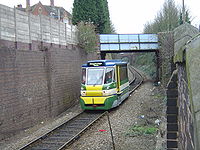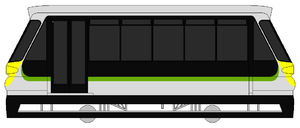
British Rail Class 139
Encyclopedia


TOPS
Total Operations Processing System, or TOPS, is a computer system for managing the locomotives and rolling stock owned by a rail system...
classification for PPM60 model lightweight railcar
Railcar
A railcar, in British English and Australian English, is a self-propelled railway vehicle designed to transport passengers. The term "railcar" is usually used in reference to a train consisting of a single coach , with a driver's cab at one or both ends. Some railways, e.g., the Great Western...
s built by Parry People Movers
Parry People Movers
Parry People Movers Ltd. is a British company manufacturing lightweight trams and railcars that use flywheel energy storage to store energy for traction, allowing electric systems to operate without overhead wires or third rails, and railcars fuelled by small gas, diesel or hydrogen engines,...
, for use on the British
United Kingdom
The United Kingdom of Great Britain and Northern IrelandIn the United Kingdom and Dependencies, other languages have been officially recognised as legitimate autochthonous languages under the European Charter for Regional or Minority Languages...
rail network. The class were originally built in 2008 for operation on the Stourbridge Town Branch Line
Stourbridge Town Branch Line
The Stourbridge Town Branch Line is a railway branch line, in Stourbridge, West Midlands, England. It is claimed to be the shortest branch line in Europe, and many miniature railways are certainly longer....
following an extensive trial with a prototype registered as a Class 999 unit.
The first newly constructed Class 139 was shown on 28 June 2008 at the Tyseley Locomotive Works Open Day. The full fleet of two units eventually entered public service on the branchline in June 2009.
Technology
The Class 139 units are typical of the Parry People Mover concept, in that they utilise flywheel energy storageFlywheel energy storage
Flywheel energy storage works by accelerating a rotor to a very high speed and maintaining the energy in the system as rotational energy...
as the main source of energy, to propel the vehicle. The flywheel
Flywheel
A flywheel is a rotating mechanical device that is used to store rotational energy. Flywheels have a significant moment of inertia, and thus resist changes in rotational speed. The amount of energy stored in a flywheel is proportional to the square of its rotational speed...
captures braking energy when the brakes are used, and re-uses the energy for acceleration. As the unit's primary motive power comes from the flywheel, this eliminates the need for a large diesel engine
Diesel engine
A diesel engine is an internal combustion engine that uses the heat of compression to initiate ignition to burn the fuel, which is injected into the combustion chamber...
. The small onboard engine is used to power up the vehicle initially, and to provide power for the onboard systems.
Usage
The concept of using the lightweight railcar came about in 2006, when a year-long pilot scheme began on the Stourbridge Town Branch LineStourbridge Town Branch Line
The Stourbridge Town Branch Line is a railway branch line, in Stourbridge, West Midlands, England. It is claimed to be the shortest branch line in Europe, and many miniature railways are certainly longer....
on Sundays, using a PPM50 unit constructed in 2002 and numbered as 999 900 under TOPS. The success of this pilot meant that the provision of regular services using the technology was incorporated in the franchise plans for the new West Midlands Franchise. Following the award of the franchise to London Midland
London Midland
London Midland is a train operating company in the United Kingdom. Legally named London and Birmingham Railway Ltd, it is a subsidiary of Govia, and has operated the West Midlands franchise since 11 November 2007....
, they placed an order for two PPM60 units with Parry People Movers, through Porterbrook
Porterbrook
Porterbrook is one of the three major ROSCOs in the United Kingdom...
leasing.
These two units are 139 001 and 139 002, composed of vehicle numbers 39001 and 39002 in the British carriage and wagon numbering and classification
British carriage and wagon numbering and classification
A number of different numbering and classification schemes have been used for carriages and wagons on Britain's railways, and this page explains the principal systems...
system. The vehicles are mechanically similar to 999 900, but are approximately one metre longer. They were intended to start operating on the Stourbridge Town branch in 2008. In January 2009 it was confirmed that 139001 was still undergoing testing at Chasewater Railway and 139002 was still not completed.
Despite the difficulties in the commissioning of the two Class 139 units, London Midland consistently outlined its faith that they would be ready to enter service. In March 2009, it was announced that the first unit had received its passenger certification from Network Rail
Network Rail
Network Rail is the government-created owner and operator of most of the rail infrastructure in Great Britain .; it is not responsible for railway infrastructure in Northern Ireland...
, allowing it to carry passengers. London Midland stated that they would begin a phased entry into service, starting with weekend operation in April, leading up to a full service by the timetable change in May 2009. Until then, London Midland temporarily returned a Class 153
British Rail Class 153
The British Rail Class 153 Super Sprinter is a single car diesel multiple unit converted from British Rail Class 155s.-Description:These units were originally built as two-car Class 155 units by British Leyland from 1987–88, but were converted by Hunslet-Barclay at Kilmarnock from 1991-92...
to operating the branch service. 139002 officially entered service on 29 March 2009 as part of the type's phased entry. This unit had previously worked in full service, including all-day on Monday 11 May 2009 and previously had worked all morning services during February/March 2009. In May 2009 the first unit, 139 001 was finally delivered to Stourbridge, with 999 900 removed at the same time. The test unit 999 900 had been on the branch line between 2005–2009. At the point of introduction, they displaced a single Class 153
British Rail Class 153
The British Rail Class 153 Super Sprinter is a single car diesel multiple unit converted from British Rail Class 155s.-Description:These units were originally built as two-car Class 155 units by British Leyland from 1987–88, but were converted by Hunslet-Barclay at Kilmarnock from 1991-92...
DMU that was previously allocated to the branch line.
Future
Parry People Movers are using London Midland's purchase of the Class 139 for the short Stourbridge line to promote the PPM concept for other lines that are short and essentially separate from the main railway network as a means of reintroducing rail travel to areas that have seen it curtailed. PPML indicated that they intended to use a variation of the PPM60 model, to be known as the PPM220, to bid for the contract to build a small fleet of experimental tram-trainTram-train
A tram-train is a light-rail public transport system where trams run both on an urban tramway network and on main-line railways to combine the tram's flexibility and availability and the train's greater speed...
s for use on the Penistone Line
Penistone Line
The Penistone Line is operated by Northern Rail in the West Yorkshire Metro/ Travel South Yorkshire area of northern England. It connects Huddersfield and Sheffield via Penistone and Barnsley, serving many rural communities...
, and for the new generation DMUs intended as part of the Government's rolling stock plan. This will entail an articulated unit, with a pair of PPM60 variants at either end of a fixed passenger unit—the whole unit will be capable of accommodating up to 220 passengers and travelling at up to 60 miles per hour (96.6 km/h) on railways or 50 miles per hour (80.5 km/h) on tramways. The Penistone trial however was cancelled before a bidder was selected and replaced in September 2009 with an electric Rotherham-Sheffield trial.
Fleet details
| Class | Operator | No. Built | Year Built | Cars per Set | Unit nos. | Length | Seated | Standing |
|---|---|---|---|---|---|---|---|---|
| Class 139 | London Midland | 2 | 2008 | 1 | 139001 - 139002 | 9.6 m | 25 | 35 |


